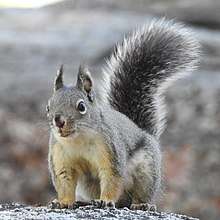Mearns's squirrel
Mearns's squirrel (Tamiasciurus mearnsi) is a species of squirrel native to Mexico.[2] It is an endangered species which occurs in low densities and is threatened by habitat loss.[1][3] It is possibly also threatened by competition from the eastern gray squirrel, which was introduced to the range of Mearns's squirrel in 1946, but may not be present anymore.[3] It is closely related to the Douglas squirrel, but far less is known about its behavior, which was first studied in detail in 2004-2005.[3] It is named for the nineteenth century American naturalist Edgar Mearns.[4]
| Mearns's squirrel | |
|---|---|
 | |
| Scientific classification | |
| Kingdom: | Animalia |
| Phylum: | Chordata |
| Class: | Mammalia |
| Order: | Rodentia |
| Family: | Sciuridae |
| Genus: | Tamiasciurus |
| Species: | T. mearnsi |
| Binomial name | |
| Tamiasciurus mearnsi (Townsend, 1897) | |
Description
Mearns's squirrel is a relatively small tree squirrel, with an average head-body length of 20 cm (7.9 in), and weighing about 270 g (9.5 oz). They have soft, dense, fur, which is grey-brown on the upper body and white with yellow patches on the underparts. There is a stripe of solid black fur on each flank, and a narrow band of reddish-yellow fur runs down the middle of the back. The tail is bushy, with darker fur than the body, but fringed with white and yellow. The fur on the head is mostly grey, becoming yellowish towards the snout, and with dark ears and clear rings of white fur around the eyes.[4]
Distribution and habitat
Mearns's squirrel is known from only three sites in the Sierra de San Pedro Mártir in Baja California, Mexico.[4] The region is surrounded by areas of chaparral and desert, isolating the tree squirrel from its closest relatives elsewhere, and indicating that it is likely a relict population isolated by forest fragmentation during the Pleistocene.[5] The three sites all consist of pine and fir forests at altitudes of 2,100–2,400 m (6,900–7,900 ft),[1] and cover an area of no more than 40,655 ha (157 sq mi).[4]
Biology and behavior
Mearns's squirrel is diurnal and herbivorous, feeding mainly on the seeds of fir and pine trees. Unlike its closest relatives, such as the Douglas squirrel, it does not hoard food for future use,[3] and it rests in cavities in trees, rather than constructing nests from leaves.[6] The squirrels do not appear to be territorial, and two individuals may sometimes share the same resting cavity.[7] Vocalizations are known to include a high-pitched "rattle", a chirp, and a barking sound.[8]
The mating season lasts from around February to August, with one or two litters of two to five young being born each year.[4]
References
- de Grammont, P. C. & Cuarón, A. (2008). "Tamiasciurus mearnsi". IUCN Red List of Threatened Species. 2008: e.T21378A9276538. doi:10.2305/IUCN.UK.2008.RLTS.T21378A9276538.en.
- Thorington, R.W., Jr.; Hoffman, R.S. (2005). "Family Sciuridae". In Wilson, D.E.; Reeder, D.M (eds.). Mammal Species of the World: A Taxonomic and Geographic Reference (3rd ed.). Johns Hopkins University Press. p. 766. ISBN 978-0-8018-8221-0. OCLC 62265494.
- Koprowski, Ramos, Pasch & Zugmeyer (2006). Observation on the ecology of the endemic Mearn's Squirrel (Tamiasciurus mearnsi). Archived 2011-06-06 at the Wayback Machine The Southwestern Naturalist 51(3): 426-430.
- Koprowski, J.L., Steele, M.A., & Ramos-Lara, N. (August 2016). "Tamiasciurus mearnsi (Rodentia: Sciuridae)". Mammalian Species. 48 (936): 66–72. doi:10.1093/mspecies/sew007.CS1 maint: uses authors parameter (link)
- Arbogast, B.S., Browne, R.A., & Weigl, P.D. (May 2001). <0302:EGAPBO>2.0.CO;2 "Evolutionary Genetics and Pleistocene Biogeography of North American Tree Squirrels (Tamiasciurus)". Journal of Mammalogy. 82 (2): 302–319. doi:10.1644/1545-1542(2001)082<0302:EGAPBO>2.0.CO;2.CS1 maint: uses authors parameter (link)
- Ramos-Lara, N., Koprowski, J.L., & Swann, D.E. (February 2013). "Nest-site characteristics of the montane endemic Mearns's squirrel (Tamiasciurus mearnsi): an obligate cavity-nester?". Journal of Mammalogy. 94 (1): 50–58. doi:10.1644/12-MAMM-A-113.1.CS1 maint: uses authors parameter (link)
- Ramos-Lara, N. & Koprowski, J.L. (June 2012). "Communal nesting behavior in Mearns's squirrels (Tamiasciurus mearnsi)". Southwestern Naturalist. 57 (2): 195–225. doi:10.1894/0038-4909-57.2.195.CS1 maint: uses authors parameter (link)
- Smith, C.C. (November 1978). "Structure and function of the vocalizations of tree squirrels (Tamiasciurus)". Journal of Mammalogy. 59 (4): 793–808. doi:10.2307/1380144.CS1 maint: uses authors parameter (link)
External links
| Wikispecies has information related to Tamiasciurus mearnsi |
